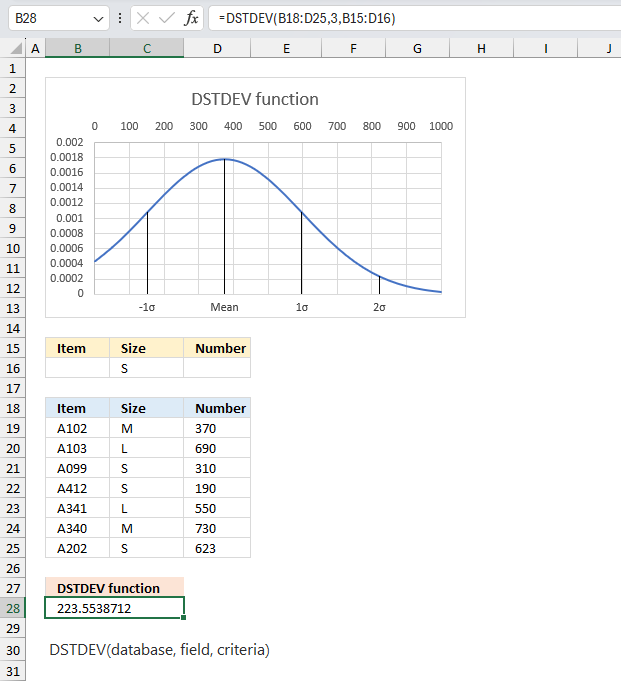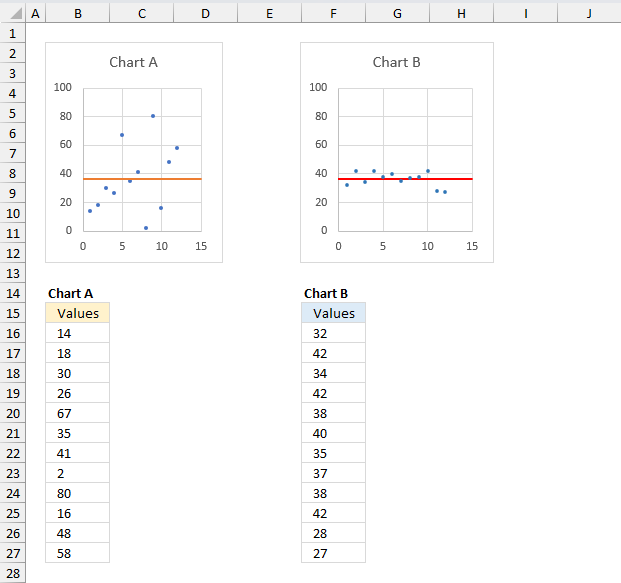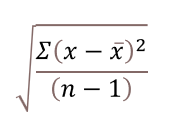How to use the DSTDEV function

What is the DSTDEV function?
The DSTDEV function calculates an estimation of the standard deviation based on a sample of a population. The function allows you to specify criteria applied to a population/database.
Table of Contents
1. Introduction
What is DSTDEV an abbreviation of?
DSTDEV is an abbreviation of Database Standard Deviation.
What is a database in this context?
Excel defines a database as a list of related data in which rows of related information are records, and columns of data are fields. The first row of the list contains labels for each column.
Why use the DSTDEV function?
The DSTDEV function multiplies numbers that match a condition or criteria in a list/database whereas the STDEV.S function performs a calculation without a condition/criteria.
Where can you place the criteria range?
You can place your criteria range wherever you want on your worksheet, however, it is not recommended below the list/database. The function needs a blank row below the list to work properly.
What criteria characters are allowed?
Allowed criteria range characters are less than and greater than signs <>, use them to specify a criteria range. Also, asterisks * can be used to match partial strings.
What is a STDEV?

STDEV stands for standard deviation. It tells you how far from the average values are spread out. Both charts above have numbers and an average plotted, they share the exact same average however, the numbers are not the same.
Chart A above shows that the values are more spread out than the values in chart B. Chart A has a standard deviation of 23.45256334, standard deviation for chart B is 5.207075606. Standard deviation is fundamental in statistics.
What is the difference between the DSTDEV function and the DSTDEVP function?
DSTDEVP function calculates the standard deviation for a population and the DSTDEV function calculates the standard deviation for a sample. DSTDEVP uses the count of all values (n) in the denominator.
DSTDEV uses (n-1) in the denominator (Bessel's correction). This accounts for the difference between sample variance and population variance in statistics. DSTDEV is better for sample inferential statistics.
DSTDEVP math formula:

DSTDEV math formula:

When to use the DSTDEVP function and the DSTDEV function?
Use DSTDEVP if you have the full population data. Use DSTDEV if you have a sample of limited data from a larger population. DSTDEVP will result in a lower standard deviation compared to DSTDEV on the same data.
Sample standard deviation is considered a better estimate for inferring population parameters.
What is inferring population parameters?
Population parameters refer to the actual values of statistics that describe an entire population, such as the population mean or standard deviation. However, the true population parameter values are often not known.
What is sample inferential statistics?
Sample inferential statistics are methods that allow using statistics calculated on a sample of data to infer the unknown population parameters.
For example:
- The sample mean can be used to estimate the population mean.
- The sample standard deviation can estimate the population standard deviation.
2. Syntax
DSTDEV(database, field, criteria)
| database | Required. The cell reference to a list or database. |
| field | Required. The field argument lets you choose which column to use. You can use the column name enclosed with double quotation marks or the corresponding column number. |
| criteria | Required. A cell reference to the criteria range. The criteria range needs to have column labels and at least one condition below the column label. |
3. Example 1

This is an Excel function that calculates the standard deviation of a specific column (field) within a data range based on provided criteria.
The formula in cell B15 is
Arguments:
- B18:C25 - This is a range reference that contains the data for the calculation. It includes the Item, Size and Number columns from rows 5 to 12.
- 3 - This is a number that specifies the data field for which the standard deviation is to be calculated. In this case, 3 refers to the Number column within the data range.
- B3:C3 - This is another range reference that contains the criteria for the calculation. In this case, it includes the value "S" in cell C3, which is the criteria for the Size column.
The data in the referenced ranges:
- B18:C25 contains a list of items with their sizes and associated numbers.
| Item | Size | Number |
| A102 | M | 370 |
| A103 | L | 690 |
| A099 | S | 310 |
| A412 | S | 190 |
| A341 | L | 550 |
| A340 | M | 730 |
| A202 | S | 623 |
- 3 represents the field number. B5:C12 contains three columns, the formula calculates the standard deviation based on the numbers in the third column.
- B15:D16 includes the value "S" in cell C16, which is the criteria for the calculation.
The DSTDEV function calculates the standard deviation of the Number values for those rows where the Size value matches the criteria "S". The result 223.55538712 is obtained by calculating the standard deviation of the numbers for items with size "S" in the data range. These items are A099, A412, and A202, with numbers 310, 190, and 623, respectively.
The image above shows a normal distribution (blue curve) with a mean of 374 and a standard deviation of 224. The mean is the center of the blue curve and σ represents the standard deviation.
Mean = 374
Std dev = 224
1σ = 598
2σ = 821
3σ = 1045
-1σ = 151
-2σ = -73
-3σ = -296
The math formula behind the calculation in cell B15 is:
√(Σ(x-x̄)2/(n-1))
Σ - sum
x̄ - the mean
x - all x values
n - number of x values
√ - square root
2 - square
To calculate the standard deviation from a sample based on the following observations 310, 190, and 623:
- Find the mean (x̄) of the observations:
x̄ = (310 + 190 + 623) / 3
x̄ = 1123 / 3
x̄ = 374.33 - Calculate the deviation of each observation from the mean (x - x̄):
310 - 374.33 = -64.33
190 - 374.33 = -184.33
623 - 374.33 = 248.67 - Square each deviation:
(-64.33)^2 = 4138.45
(-184.33)^2 = 33973.89
(248.67)^2 = 61838.45 - Sum the squared deviations:
4138.45 + 33973.89 + 61838.45 = 99950.79 - Divide the sum of squared deviations by (n - 1), where n is the number of observations:
99950.79 / (3 - 1) = 99950.79 / 2 = 49975.395 - Take the square root of the result from step 5:
√49975.395 = 223.55538712
The standard deviation of the sample observations 310, 190, and 623 is 223.55538712, which matches the result shown in the image.
4. Function not working

The DSTDEV function
- returns a #VALUE! error if the field argument is out of range.
- propagates errors in the source data.
4.1 Troubleshooting the error value

When you encounter an error value in a cell a warning symbol appears, displayed in the image above. Press with mouse on it to see a pop-up menu that lets you get more information about the error.
- The first line describes the error if you press with left mouse button on it.
- The second line opens a pane that explains the error in greater detail.
- The third line takes you to the "Evaluate Formula" tool, a dialog box appears allowing you to examine the formula in greater detail.
- This line lets you ignore the error value meaning the warning icon disappears, however, the error is still in the cell.
- The fifth line lets you edit the formula in the Formula bar.
- The sixth line opens the Excel settings so you can adjust the Error Checking Options.
Here are a few of the most common Excel errors you may encounter.
#NULL error - This error occurs most often if you by mistake use a space character in a formula where it shouldn't be. Excel interprets a space character as an intersection operator. If the ranges don't intersect an #NULL error is returned. The #NULL! error occurs when a formula attempts to calculate the intersection of two ranges that do not actually intersect. This can happen when the wrong range operator is used in the formula, or when the intersection operator (represented by a space character) is used between two ranges that do not overlap. To fix this error double check that the ranges referenced in the formula that use the intersection operator actually have cells in common.
#SPILL error - The #SPILL! error occurs only in version Excel 365 and is caused by a dynamic array being to large, meaning there are cells below and/or to the right that are not empty. This prevents the dynamic array formula expanding into new empty cells.
#DIV/0 error - This error happens if you try to divide a number by 0 (zero) or a value that equates to zero which is not possible mathematically.
#VALUE error - The #VALUE error occurs when a formula has a value that is of the wrong data type. Such as text where a number is expected or when dates are evaluated as text.
#REF error - The #REF error happens when a cell reference is invalid. This can happen if a cell is deleted that is referenced by a formula.
#NAME error - The #NAME error happens if you misspelled a function or a named range.
#NUM error - The #NUM error shows up when you try to use invalid numeric values in formulas, like square root of a negative number.
#N/A error - The #N/A error happens when a value is not available for a formula or found in a given cell range, for example in the VLOOKUP or MATCH functions.
#GETTING_DATA error - The #GETTING_DATA error shows while external sources are loading, this can indicate a delay in fetching the data or that the external source is unavailable right now.
4.2 The formula returns an unexpected value

To understand why a formula returns an unexpected value we need to examine the calculations steps in detail. Luckily, Excel has a tool that is really handy in these situations. Here is how to troubleshoot a formula:
- Select the cell containing the formula you want to examine in detail.
- Go to tab “Formulas” on the ribbon.
- Press with left mouse button on "Evaluate Formula" button. A dialog box appears.
The formula appears in a white field inside the dialog box. Underlined expressions are calculations being processed in the next step. The italicized expression is the most recent result. The buttons at the bottom of the dialog box allows you to evaluate the formula in smaller calculations which you control. - Press with left mouse button on the "Evaluate" button located at the bottom of the dialog box to process the underlined expression.
- Repeat pressing the "Evaluate" button until you have seen all calculations step by step. This allows you to examine the formula in greater detail and hopefully find the culprit.
- Press "Close" button to dismiss the dialog box.

There is also another way to debug formulas using the function key F9. F9 is especially useful if you have a feeling that a specific part of the formula is the issue, this makes it faster than the "Evaluate Formula" tool since you don't need to go through all calculations to find the issue..
- Enter Edit mode: Double-press with left mouse button on the cell or press F2 to enter Edit mode for the formula.
- Select part of the formula: Highlight the specific part of the formula you want to evaluate. You can select and evaluate any part of the formula that could work as a standalone formula.
- Press F9: This will calculate and display the result of just that selected portion.
- Evaluate step-by-step: You can select and evaluate different parts of the formula to see intermediate results.
- Check for errors: This allows you to pinpoint which part of a complex formula may be causing an error.
The image above shows cell reference B18:D25 converted to hard-coded value using the F9 key. The DSTDEV function requires non-error values which is not the case in this example. We have found what is wrong with the formula.
Tips!
- View actual values: Selecting a cell reference and pressing F9 will show the actual values in those cells.
- Exit safely: Press Esc to exit Edit mode without changing the formula. Don't press Enter, as that would replace the formula part with the calculated value.
- Full recalculation: Pressing F9 outside of Edit mode will recalculate all formulas in the workbook.
Remember to be careful not to accidentally overwrite parts of your formula when using F9. Always exit with Esc rather than Enter to preserve the original formula. However, if you make a mistake overwriting the formula it is not the end of the world. You can “undo” the action by pressing keyboard shortcut keys CTRL + z or pressing the “Undo” button
4.3 Other errors
Floating-point arithmetic may give inaccurate results in Excel - Article
Floating-point errors are usually very small, often beyond the 15th decimal place, and in most cases don't affect calculations significantly.
Functions in 'Database' category
The DSTDEV function function is one of 11 functions in the 'Database' category.
How to comment
How to add a formula to your comment
<code>Insert your formula here.</code>
Convert less than and larger than signs
Use html character entities instead of less than and larger than signs.
< becomes < and > becomes >
How to add VBA code to your comment
[vb 1="vbnet" language=","]
Put your VBA code here.
[/vb]
How to add a picture to your comment:
Upload picture to postimage.org or imgur
Paste image link to your comment.
Contact Oscar
You can contact me through this contact form